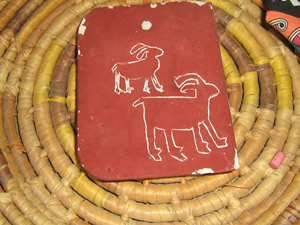Sacred Images - The Art of Weaving
Summary
Many Native American tribes have stories of creation about Grandmother Spider who, with God, created the Earth and all the things upon it. With the help of the animals, she separated the people into clans. The animals led the people to the places where they built their homes and settled. Native American Indians realize the virtues of spider's keen awareness, its patience, and how it brings a balance in nature. Spider webs symbolize the interconnectedness of all things. The web connects all things, creating a balance. If we stop our activities and observe a spider or its web, we may hear the solutions to heal our world, the Earth, the animals, and the humans. We are all connected.
Materials
Attachments
- Keepers of the Animals, "Creation Stories" (Caduto and Bruchac, 1991).
- The Goat in the Rug as told to Charles Blood and Martin Link
- Photographs or examples of spider webs.
- Yarn, cut into 1-2 yard lengths
- Patterns of the Basket "spokes" (warp "threads").
- Tewa Song of the Sky Loom, and Weaving Home poem
Background for Teachers
According to the Hopi, Spider Woman put things on Earth in order. She separated the people into tribes, choosing a different animal to lead each tribe to the place where they live today. The symbols created by the Ancients include various animals, as well as circular shapes. Compare and contrast a spider's web with some of those in The Goat in the Rug. Compare the art of weaving with the web of a spider. Discuss the warp (vertical rigid threads), and weft (horizontal working threads) and help the students determine which is which on a picture of a spider's web. One of the earliest forms of art is created by weaving, The ancient Paleo-Indians wove fine textiles and sandals 10,000 years ago when the earliest Rock Art in Utah was created (Barrier Canyon style). The art of weaving developed and became more elaborate when the loom was introduced during the Anasazi Period. Today, the Navajo are great artists, creating beautiful turquoise jewelry, as well as skilled woven textiles and rugs.
Student Prior Knowledge
For the Student: Imagine the skill that it takes for a spider to construct its web. Observe a spider making its web, and compare that to the way that that humans weave. Look for symbols in the photographs of Rock Art that are similar to a spider's web, and think about what Chief Seattle meant by the "web of life". What do you think the Rock Art artists meant to express with their symbols?
Instructional Procedures
Activity: Weaving a basket
- Instruct the students to trace over a basket spoke pattern and cut out their own.
- Instruct students to draw some of the symbols they remember from Sacred Images A Vision of Native American Rock Art in the center of one side of their spoke pattern.
- Next, students tie one end of their yarn to a spoke of their pattern.
- Soft Native American flute music can be played and students should be reminded that weaving is done in a quiet, reflective way.
- They can begin to weave their "weft" thread over and under each spoke.
- When the yarn runs out, another piece can be tied to the previous, and the weaving continues until the basket begins to curl upward, forming a bowl shape and many pieces of yarn have been used.
- When the threads reach approximately ½ inch to the end of the spokes, weaving discontinues, and the last piece of yarn must be secured to a spoke with a knot.
- To keep the threads from slipping over the ends of the spokes, bend each spoke over and back into some of the woven threads.
- Glue may also be applied to the top ½ inch of spokes before folding back over the threads.
- Baskets can be used to hold jewelry, office supplies, or for decorative purposes.

Extensions
Attachments
Updated: 02/05/2018


 UTAH EDUCATION NETWORK
UTAH EDUCATION NETWORK

 Justin
Justin Braxton
Braxton Dani
Dani Kayla
Kayla Katie
Katie Matthew
Matthew Rob
Rob Val
Val
